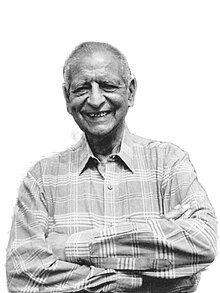Kekoo Gandhy
This article, Kekoo Gandhy, has recently been created via the Articles for creation process. Please check to see if the reviewer has accidentally left this template after accepting the draft and take appropriate action as necessary.
Reviewer tools: Inform author |
This article, Kekoo Gandhy, has recently been created via the Articles for creation process. Please check to see if the reviewer has accidentally left this template after accepting the draft and take appropriate action as necessary.
Reviewer tools: Inform author |
 Comment: Please find several sources not connected with Keekoo Gandhy, such as news reports, reviews, magazine articles, etc., to confirm the information in this article. The sources should include mostly what others have said about him, rather than what he has said about himself. Also, the use of "op. cit." is not appropriate, since when there are several references it will be confusing; use named citations instead. —Anne Delong (talk) 15:08, 17 April 2013 (UTC)
Comment: Please find several sources not connected with Keekoo Gandhy, such as news reports, reviews, magazine articles, etc., to confirm the information in this article. The sources should include mostly what others have said about him, rather than what he has said about himself. Also, the use of "op. cit." is not appropriate, since when there are several references it will be confusing; use named citations instead. —Anne Delong (talk) 15:08, 17 April 2013 (UTC)
Kekoo Gandhy | |
|---|---|
 | |
| Born | Kaikhushru Minochair Gandhy 2 February 1920 |
| Died | 10 November 2012 (aged 92) |
| Nationality | Indian |
| Occupation | Gallerist |
| Spouse |
Khorshed Adenwalla (m. 1944) |
| Children | Four |
Kekoo Gandhy (2 February 1920 - 10 November 2012) was an Indian art gallery owner who pioneered the promotion of Indian modern art from the 1940s.
Life and Career
Kaikhushru (Kekoo) Minocher Gandhy was born in Bombay on 2 February 1920 to Minocher Gandhy and Roshan Gandhy (née Roshan Batliwalla). Kekoo was educated at Bombay's Cathedral and John Connon School, from which he matriculated aged 17, gaining a place at Pembroke College, Cambridge. But after spending summer 1939 in India, Kekoo Gandhy could not return to Cambridge due to the outbreak of World War II. In 1940, Kekoo was appointed Honorary Secretary of the Bombay Art Society, the first Indian to hold the position.[1]
In 1941, Kekoo and his brother Russy Gandhy set up the Chemical Moulding Manufacturing Company, later abbreviated to Chemould, to manufacture frames for paintings.[2] Kekoo displayed Bombay Progressive Artists' Group paintings in Chemould's Bombay shop, which grew out of a godown on Princess Street; the Bombay Progressives made their first sales through this shop.[2] Gallery/shop managers included Roshan Kalapesi and poet Nissim Ezekiel.[3]
Kekoo's exhibitions helped establish the reputations of MF Husain, Tyeb Mehta, Ram Kumar, SH Raza, Bhupen Khakhar, Nalini Malani, Atul Dodiya, Anju Dodiya, Jitish Kallat, Reena Saini Kallat, KH Ara, Bal Chhabda, Krishen Khanna, Jehangir Sabavala, Gaitonde, KK Hebbar, Vivan Sundaram, and Jivya Soma Mashe.[2][4]
Immediately after his successful first Husain exhibition, in 1951, Kekoo Gandhy collaborated with industrialist and collector Cowasji Jehangir and the nuclear scientist Homi Bhabha to establish the Jehangir Art Gallery in Bombay, a first for modern art.[5][4] Kekoo established Gallery Chemould in 1963 on the first floor of the Jehangir Art Gallery, holding exhibitions there until 2007, when it moved to new premises in Prescott Road.[6]
Starting in the 1970s, Kekoo Gandhy was instrumental in developing the former Sir Cowasji Jehangir Public Hall in Bombay into the present National Gallery of Modern Art, Mumbai.[7] At various times Kekoo also actively supported the Lalit Kala Akademi (National Academy of Fine Arts) and Triennale India 1968.[5]
As part of his commitment to the social sphere, Kekoo Gandhy sheltered activists in his home during the Indian Emergency (26 June 1975 – 21 March 1977). And during the Hindu fundamentalist Bombay Riots (December 1992 – January 1993) he was active in the mohalla (neighbourhood) committees that worked for inter-religious solidarity.[4]
For his work in the Arts, Kekoo Gandhy was awarded the Padma Shri in 2008.
Kekoo Gandhy appears thinly-disguised as Parsi gallery owner 'Kekoo Mody' in Salman Rushdie's The Moor's last sigh.[8]
References
- ^ Sharda Dwiwedi, Artists' Centre, Mumbai http://www.artistscentre.org/theartdistrict.htm
- ^ a b c Meher Marfatia 'Kekoo Gandhy: Guru, mentor, patron, critic and more' Times of India 11 Nov 2012 http://articles.timesofindia.indiatimes.com/2012-11-11/people/35049493_1_kekoo-gandhy-bombay-art-society-m-f-husain
- ^ Nandini Bhaskaran 'Perfect frame' The Hindu 7 Mar 2004 http://www.hindu.com/mag/2004/03/07/stories/2004030700290100.htm
- ^ a b c Nancy Adajania 'Beyond the Commodity Fetish: Art and the Public Sphere in India' Guggenheim New York http://blogs.guggenheim.org/map/beyond-the-commodity-fetish-art-and-the-public-sphere-in-india/
- ^ a b Ranjit Hoskote 'Requiem for a pioneer' Art in America 27 Dec 2012 http://www.artinamericamagazine.com/features/requiem-for-a-pioneer/
- ^ Karin Zitzewitz 'Framing a gallery of heroes' Art India 2 Feb 2013 http://www.artindiamag.com/quarter_02_02_13/framing_gallery_of_heroes.html
- ^ Shivaprasad M Khened (Director) NGMA, Mumbai http://www.ngmaindia.gov.in/ngma_mumbai.asp
- ^ Stuti Khanna 'Art and the city: Salman Rushdie and his artists' The Free Library 2006 http://www.thefreelibrary.com/Art+and+the+city%3a+Salman+Rushdie+and+his+artists.-a0169211566

